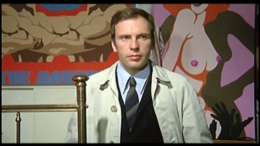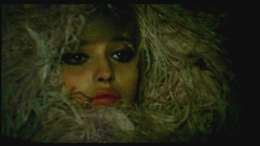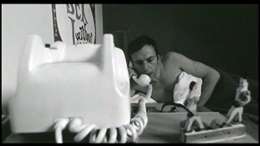
Directed by Tinto Brass / Starring Jean-Louis Trintignant, Ewa Aulin, Roberto Bisacco, Charles Kohler, Luigi Bellini
Cult Epics (US R1 NTSC) / WS (1.78:1) (16:9)
 Long before he became one of Europe's most accomplished exporters of playful erotica, Tinto Brass got his start in the 1960s with a string of oddball, genre-tweaking cinematic statements heavily influenced by pop art and the international avant garde. After tackling the spaghetti western (Yankee) and even a sci-fi comedy (The Flying Saucer), Brass veered into the increasingly popular thriller genre with the unjustly neglected Con cuore in gola ("Heart in His Mouth"), released on DVD under its obscure English release title, Deadly Sweet. The film marked the first real starring vehicle for Ewa Aulin, a former Miss Teen Sweden who became the center of a brief publicity whirlwind in 1968 as the lead in the much-discussed Candy before turning out a few more oddball European cult films, including the unjustly ignored The Double. Her co-star here is Jean-Louis Trintignant, one of France's most reliable leading men who had just become a hot property as the star of A Man and a Woman. He and Aulin reteamed immediately
Long before he became one of Europe's most accomplished exporters of playful erotica, Tinto Brass got his start in the 1960s with a string of oddball, genre-tweaking cinematic statements heavily influenced by pop art and the international avant garde. After tackling the spaghetti western (Yankee) and even a sci-fi comedy (The Flying Saucer), Brass veered into the increasingly popular thriller genre with the unjustly neglected Con cuore in gola ("Heart in His Mouth"), released on DVD under its obscure English release title, Deadly Sweet. The film marked the first real starring vehicle for Ewa Aulin, a former Miss Teen Sweden who became the center of a brief publicity whirlwind in 1968 as the lead in the much-discussed Candy before turning out a few more oddball European cult films, including the unjustly ignored The Double. Her co-star here is Jean-Louis Trintignant, one of France's most reliable leading men who had just become a hot property as the star of A Man and a Woman. He and Aulin reteamed immediately  afterward for 1968's Death Laid an Egg, an even stranger variation on giallo conventions that earned a considerably larger cult following than Brass' quirky effort, which eventually made its long-delayed American video debut courtesy of the magic of DVD.
afterward for 1968's Death Laid an Egg, an even stranger variation on giallo conventions that earned a considerably larger cult following than Brass' quirky effort, which eventually made its long-delayed American video debut courtesy of the magic of DVD.
After identifying the body of her father at the morgue, pretty Jane (Aulin) and her brother, Jerome (Kohler), and stepmother (Vera Silenti), decide to cope with their loss like any normal family, by blowing off steam at a nightclub. There she catches the eye of Bernard (Trintignant), a romantic soul who doesn't get a chance to talk to her -- at least at first. The next time he sees her is shortly afterwards, standing over the dead body of the club owner insisting she didn't do it. Impulsively he agrees to help her flee the building, and together they embark on a wild journey across London crossing paths with the dead man's associates, including a hot-tempered dwarf and a memorable gangster named Jellyroll. Along the way they also indulge in a bizarre homage to Blow-Up's paper orgy and try to find the real killer, with Jane suspecting her brother might be behind it all thanks to an intricate backstory involving blackmail and some elusive incrimianting photos. Of course, a final surprise is still waiting...
 Ostensibly based on a novel by regular Sergio Leone scribe Sergio Donati, Deadly Sweet barely tries to hang together as a narrative (at least superficially), instead deriving most of its energy from the free-flowing avalanche of pop culture nods and images cut together with a comic book sensibility extending to colorful panel inserts cut into the frames during moments of violence or heavy action. In a highly unusual move for the time, comic artist Guido Crepax (Baba Yaga) was recruited to actually storyboard the film to give it a strong graphic quality, thus making it a legitimate companion film to such Italian fumetti films as Danger: Diabolik and the Kriminal and Phenomenal films. Granted, there aren't any building-scaling superthieves in this one, but the stylistic realtionship is unmistakable. None of the actors are really required to do much beyond serving as eye candy components for the most part, but Trintignant does find quite a bit of pathos in his character from time to time, especially the haunting final scene. Another strong component is the wonderful lounge score by Armando Trovajoli, most of which revolves around a catchy little ditty called "Love Girl." The Antonioni references seem to serve more than one purpose here, as along with the London setting and obvious homages, this film can also be approached from several different angles and enjoyed on multiple levels depending on one's mood and attitude.
Ostensibly based on a novel by regular Sergio Leone scribe Sergio Donati, Deadly Sweet barely tries to hang together as a narrative (at least superficially), instead deriving most of its energy from the free-flowing avalanche of pop culture nods and images cut together with a comic book sensibility extending to colorful panel inserts cut into the frames during moments of violence or heavy action. In a highly unusual move for the time, comic artist Guido Crepax (Baba Yaga) was recruited to actually storyboard the film to give it a strong graphic quality, thus making it a legitimate companion film to such Italian fumetti films as Danger: Diabolik and the Kriminal and Phenomenal films. Granted, there aren't any building-scaling superthieves in this one, but the stylistic realtionship is unmistakable. None of the actors are really required to do much beyond serving as eye candy components for the most part, but Trintignant does find quite a bit of pathos in his character from time to time, especially the haunting final scene. Another strong component is the wonderful lounge score by Armando Trovajoli, most of which revolves around a catchy little ditty called "Love Girl." The Antonioni references seem to serve more than one purpose here, as along with the London setting and obvious homages, this film can also be approached from several different angles and enjoyed on multiple levels depending on one's mood and attitude.
As with many Italian productions, Deadly Sweet utilized an international cast with most of the principals speaking English on the set and the final soundtracks in English, Italian, etc. created during post-production. Numerous variants were then created, and each country wound up getting something slightly different -- with two different English tracks created, one by the European distributors and another by Paramount for an insignificant American. (For an excellent and very extensive breakdown of the film's possible meanings and convoluted release history, click here). A few scarce VHS editions popped up throughout Europe, followed by a pair of DVD releases in Spain and Italy, but none of them were English friendly. The Cult Epics release contains the complete Italian version with optional English subtitles, and while it quite obviously looks like a PAL conversion (with the 16:9 framing slightly cropping in the original 1.66:1 compositions, which muffs a few compositions), this version is by all reports the best as it features more accurate color grading and corrects some digital chicanery performed on the Italian one. In any case, it's a film well worth discovering for any adventurous fan of international cinema willing to dig a little deeper than the usual thriller offering, and Brass fans should be delighted to see an early example of the audacious experimentation which would soon come into full bloom with L'Urlo and Nerosubianco. The disc's extras include a theatrical trailer (which looks like it was created far more recently) and a full audio commentary by Brass, who apparently hasn't seen the film in a while and spends most of the time discussing the locations, shooting schedule, and character motivations. His accent will probably make it tough going for casual viewers, but his comments are always amusing even when they bear little relation to the film at hand. In any case, it's a real gem ripe for discovery after years of neglect.
![]()